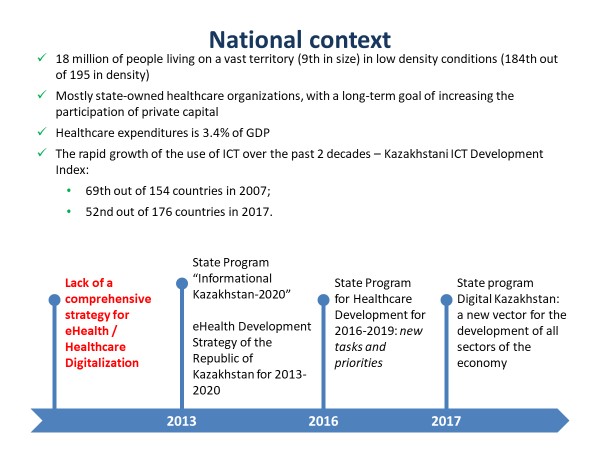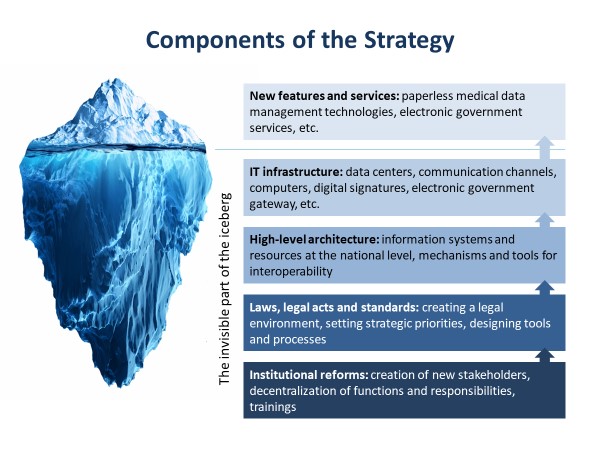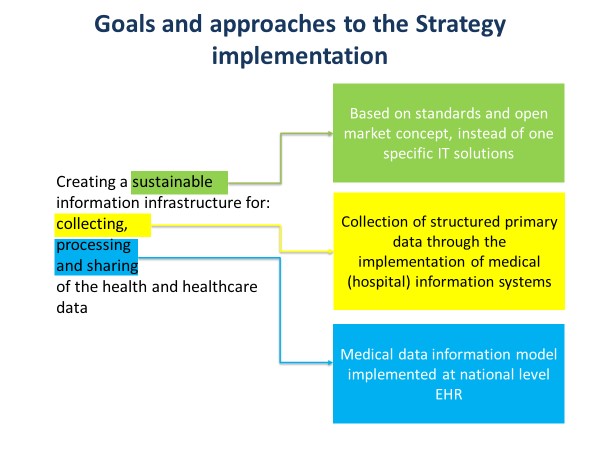Меню
Страницы
Статья
Digital Journey: Kazakhstan’s Healthcare
- Digital transformation of healthcare in Kazakhstan. Was it a gradual and smooth process? Or was it met with skepticism from the population and other stakeholders?
The process of healthcare system informatization in Kazakhstan went through several stages of development before it evolved to a state capable of providing a digital transformation of processes and data.
Considering that the healthcare system (medical service providers) in the country remains to be mainly state-owned, the Ministry of Healthcare of the Republic of Kazakhstan has been the key and only player in the field of informatization for the long period.
The first steps towards the widespread adoption of ICT in health care began in the 90s of the 20th century with the introduction of basic information systems aimed at the formation of aggregated (not personalized) databases, mainly for state statistics. In the early 2000s, the Ministry of Healthcare developed a set of registers to collect data on the medical care provided to people with certain types of diseases, such as chronic renal failure, diabetes, tuberculosis, etc.
In 2006, the national project “Unified Health Information System” was launched. Under this project, the Ministry of Healthcare planned to create a single software product that would provide functions to informatize (automate) all the main functions in the healthcare system, from collecting medical data at the level of health care providers, to monitoring the quality of medical services at the level of the national agency responsible for this function. The project was delayed beyond the originally planned deadlines and by 2012 it became clear that its implementation and full-scale deployment is almost impossible due to a number of obstacles, from technological (outdated client-server architecture, software quality problems, etc.) to conceptual (lack of users involvement into the design and development process, leading to a low level of acceptance of changes and rejection among healthcare professionals; lack of sustainability of the proposed changes; etc.). This huge project for a long time has been managed by one small unit within the Ministry of Health, which was not able to provide a needed level of planning, control, acceptance, testing, evaluation and tracking of changes, etc.
At that moment, a joint project of the Government of the Republic of Kazakhstan and the World Bank, called Kazakhstan Health Sector Technology Transfer and Institutional Reform Project was implementing. As part of this project, an independent international audit of the Unified Health Information System was conducted, the results of which served as a starting point for the development and adoption of a long-term strategy for the e-health development for 2013-2020.

Under this strategy, a transition was made from the previously used top-down model to a balanced approach, which ensures increased participation of stakeholders at different levels of the healthcare system. The Ministry of Health transferred part of the previously performed functions and responsibilities to other participants, created the conditions for the emergence and development of an open but regulated eHealth market.
At the very beginning of the development of the national strategy, in addition to the Ministry of Health, the Government of the Republic of Kazakhstan and World Bank experts took an active part. The draft strategy was reviewed and approved at a meeting of the Government of the Republic of Kazakhstan. After the approval of the strategy, the Ministry ensured a series of round tables and seminars, during which new approaches and principles were communicated to the medical and IT community. At first, there was some skepticism from health care providers, however, the initial critical mood was overcome as the most active medical organizations became involved in the digitalization process and positive examples and achievements began to appear.
Currently, the Ministry is making some serious changes in the national legislation regarding digitalization processes, as a result, the public attention is focused on issues related to the protection and confidentiality of personal medical data. In particular, there is a stratification of opinions regarding the introduction of the presumption of consent principle concerning capturing and sharing of digital medical data during medical care provision.
2. As the world’s largest landlocked country, introducing telemedicine makes sense to provide the country’s inhabitants to quality healthcare, wherever they live. Even if the telemedicine network launched in 2004, I read that as of 2018, the digital health app has about 2 million registered users. What would be the reason hindering more people to adopt the app or are there any particular reasons that the service has not reached out to others yet?
Kazakhstan has a vast territory and low population density (below 6 people per 1 sq. km.). Given this, the issue of physical accessibility of medical care remains a problem, especially for remote rural areas. The country has an extensive network of primary care, but getting specialized care can be a problem. To solve this problem, the Ministry in the mid-2000s began the implementation of a national telemedicine network project. The network allows connecting of the remote rural medical organizations to large regional and national hospitals, based on the principle of “doctor to doctor”. Thereby healthcare professionals can receive consultations from specialists with extensive experience regarding diagnosis and treatment of patients, to share the results of diagnostic studies and medical images. This reduces time and money spending on long trips for patients. In total, about 200,000 consultations were held during the existence of the telemedicine network.
In addition to this network, several private projects are being implemented in the country aimed at the direct interaction of patients with medical workers, including remote consultations with specialists in various fields.
The eGovernment portal has implemented a number of services that allow patients to make an appointment, get access to their medical information (diagnoses, medical services received, prescriptions made) online.
More than 2 million people use mobile applications offered by various private vendors of medical (hospital) information systems. Such applications allow users to receive a wide range of services and information, including, but not limited to:
- access to their medical records, including laboratory test results, prescriptions, referrals,
- to make an appointment with a doctor, diagnostic or treatment procedures,
- to make an emergency call by the click of a button,
- receive personalized alerts and notifications, etc.
Reaching 2 million users is a definite achievement for the Ministry, as this number of users represents 17% of the entire adult population of the country, including older people. For comparison, at the beginning of 2019, the country had 2.5 million active mobile social users.
3. What were the challenges that the ministry of health came across to bring the eHealth Development Strategy to fruition?
At the beginning of the Strategy implementation, there were practically no institutional structures and specialists in the country who would have in-depth knowledge and experience regarding various aspects of e-health. At the level of medical organizations, many medical workers, especially older ones, did not possess computer literacy to the extent necessary for the daily use of information systems. In most medical organizations, computer equipment was below 50% of the need. In remote rural areas, there were problems with the quality and accessibility of the Internet. In addition, many medical organizations and local healthcare authorities were not active and were not interested in implementing ICT.
4. In Rwanda, one of the leaders in digital health in Africa, start-ups and entrepreneurs, mainly from Asia, co-shape regulations with the government to bring digital health solutions to the country. How is the ministry of health/government of Kazakhstan encouraging competition to drive forward the digitization of the healthcare sector, as your ppt highlighted the fact of having a single major vendor to be a negative factor in moving ahead the country’s digitization plans?
The involvement of all stakeholders is a key principle of our Strategy, without which it would be impossible to create an open e-health market. The Ministry conducted explanatory and educational work primarily among the medical community. Additionally, to activate vendors of medical information systems, the Ministry implemented a pilot project to implement such systems free of charge for selected medical organizations. To ensure ongoing dialogue, the Ministry has created a Digitalization Council, which includes representatives of the medical and IT community, as well as NGOs in the field of e-health.
Also, the Ministry has been organizing hackathons for several years, often jointly with international partners and UN agencies. The international conference and exhibition Digital Health Astana was held twice (in 2018 and 2019) in which local and foreign IT companies were participated.
5. With digitization, we often come across the issue of data privacy and security. What steps have your ministry taken to ensure that patients can trust their data into your hands?
A lot of work has been done in this direction, started with the introduction of legislative norms and standards that define the requirements, rights, and obligations regarding the access and use of personal medical data. All information systems and databases at the national level were transferred to secure data centers. All information systems of the Ministry have been certified for the requirements of national information security standards. Training on information security is constantly conducted. All this allowed in 2019 to prevent 130,724 external attacks.
6.You’ve had the eHealth Development Strategy for 2013-2020 planned out. How would you rate the success of the strategy given that we’ve reached the final year? Any projects that couldn’t be implemented?

The roadmap for the strategy implementation includes the following 5 areas:
- Institutional development and capacity building - within the framework of this area, institutional structures have been created at the national level to ensure the implementation of key e-health development functions. A Department of Health Digitalization has been established as part of the Ministry of Healthcare, with functions for policymaking, strategy development, and regulation. The Republican Center for Electronic Health has been established to ensure the management, coordination, and implementation of ICT projects at the national level, to develop an eHealth architecture, to develop and support information systems of the Ministry of Healthcare, to facilitate the implementation of regional projects. The Technical Committee for Standardization No. 83 “E-Health” has been formed to implement the development, harmonization, and approval of national standards. The necessary amendments have been made to the country's legislation to ensure the legitimacy of e-health and digital medical data, and to determine the rights and obligations of stakeholders. A wide range of stakeholders was trained on a wide range of e-health issues.
- Stimulation and development of the e-health market - the initial intention was to ensure the availability of about 10 vendors in the country and the implementation of modern medical (hospital) information systems in 20% of the medical organizations in Kazakhstan by 2020. As of now, about 40 vendors are operating in the country, including both Kazakhstani and foreign companies. Information systems are implemented in all medical organizations of the country, up to rural hospitals. Such progress has allowed in 2018 to begin a pilot project on paperless medical data management. Since 2019, numerous samples of medical documentation that previously had to be mandatorily filled out on paper have become digital.
- Development of standards and regulatory framework for e-health - the main efforts were aimed at supporting and developing the adopted policy of informatization of the health system through the implementation of the international and local standards. A set of standards has been formed and adopted to achieve organizational and structural interoperability of e-health, providing support for the continuity of patient care by defining conceptual and technical requirements for a national-level information infrastructure that interacts with local EMRs. Through a basic set of standards, the interoperability requirements were explicitly defined for EMRs, and, the requirements for functionality were established implicitly. The conceptual core of the standardization system is ISO 13940 Health informatics - System of concepts to support continuity of care. Additionally, the HL7 family of standards and IHE integration profiles are actively used. Since 2019, Kazakhstan joined the SNOMED International and began to adopt SNOMED.
- Development and implementation of information systems at the national level - following the conceptual architecture of e-health, since 2013, a number of systems have been created at the national level. They provide data collection and support of healthcare business processes, including:
- the management of the processes of attachment to primary care organizations and planned hospitalization;
- electronic prescriptions for outpatient drug provision;
- accounting for the services provided at different levels of medical care and financing of medical organizations;
- assessment of the quality of medical care;
- maintaining registers for individual nosology and patient groups;
- maintaining a single register of patients (population), integrated with the state database of individuals.
This year the development of the Health Integration Platform has been completed, which will ensure the interoperability of all information systems in healthcare.
- Formation of the e-health IT infrastructure - a breakthrough has been made during the implementation of the Strategy regarding the provision of IT infrastructure. At the national level, two modern distributed secure data centers have been created. All medical organizations are fully equipped with the necessary IT equipment, including PCs. Connection to reliable and high-quality communication channels is provided even for remote rural medical organizations.

Thus, we can conclude that all areas of the Strategy are fulfilled. This year, the Ministry planning to assess the implementation of the Strategy and develop a new strategic document for the next five-year period.
7. Has your ministry or does it have plans to collaborate with major international digital health players (device manufacturers, app developers) to forge ahead the digitization plans of healthcare in Kazakhstan?
The Ministry is considering collaborations with major vendors in the field of digitalization. At the moment, there are a number of signed memorandums of cooperation in the e-health. An entire department has been created and operates in the Republican Center for eHealth, which is engaged in attracting and maintaining relationships with major international vendors. Moreover, pilots were held in 2 medical organizations, and several other Proof of concepts were planned. These projects are focused on the implementation of artificial intelligence, telemedicine, augmented reality in various aspects of healthcare. Unfortunately, the concluded memoranda do not allow disclosing details and participants of these projects at the moment.

Yerbol Spataev, MPH, Member of WHO roster of experts in digital health, specialist on public health and healthcare digitalization in the World Bank’s Social Health Insurance Project.